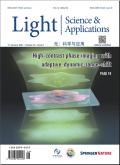Generation of tunable Raman soliton and dispersive wave beyond 4 μm in centimeter-length fluorotellurite fibers.
IF 23.4
Q1 OPTICS
引用次数: 0
Abstract
3-5-μm mid-infrared (MIR) ultrafast laser sources have garnered significant attention due to their critical applications in spectroscopy, environmental monitoring, and imaging. However, 4-5-μm compact fiber laser sources remain a significant technological challenge due to the lack of MIR fibers with good chemical stability, thermal stability, high nonlinearity, and low loss. Here, we develop fluorotellurite fibers based on 60TeO2-20BaF2-10AlF3-10Y2O3 (TBAY) glasses with a wide transmission window, demonstrating tunable Raman soliton and dispersive wave (DW) generation beyond 4 µm in centimeter-length fluorotellurite fibers pumped by a 3.54 μm femtosecond laser source. Fluorotellurite fibers with a loss of 0.39 dB/m were fabricated using a rod-in-tube method. The high numerical aperture (NA ~ 1.1@3.5 μm) of TBAY fibers allows the zero-dispersion wavelength (ZDW) to be tuned over a wide range by varying the core diameter of the fibers. The dispersion-engineered TBAY fibers with a core diameter of 6.5 μm enabled 4584 nm Raman soliton generation, while fibers with a core diameter of 3 μm enabled 4177 nm DW generation. We conducted detailed experiments to investigate the influence of pump power and fiber length on SSFS and dispersive wave dynamics. Theoretical analysis and numerical simulations based on the generalized nonlinear Schrödinger equation corroborate the experimental results. Our results show that TBAY fibers are promising nonlinear media for constructing compact ultrafast laser sources in the 4-5 μm wavelength range.可调谐拉曼孤子和4 μm以上色散波在厘米长氟碲光纤中的产生。
3-5 μm中红外(MIR)超快激光源因其在光谱学、环境监测和成像等领域的重要应用而受到广泛关注。然而,由于缺乏具有良好化学稳定性、热稳定性、高非线性和低损耗的MIR光纤,4-5 μm致密光纤激光源仍然是一个重大的技术挑战。在这里,我们基于60TeO2-20BaF2-10AlF3-10Y2O3 (TBAY)玻璃开发了具有宽透射窗口的氟碲酸盐光纤,展示了在3.54 μm飞秒激光源泵浦的厘米长度氟碲酸盐光纤中可调谐拉曼孤子和色散波(DW)产生超过4µm。采用管中棒法制备了损耗为0.39 dB/m的氟碲酸盐纤维。TBAY光纤的高数值孔径(NA ~ 1.1@3.5 μm)使得零色散波长(ZDW)可以通过改变光纤芯径在较大范围内调谐。芯径为6.5 μm的色散工程TBAY光纤可产生4584 nm的拉曼孤子,芯径为3 μm的光纤可产生4177 nm的DW。我们进行了详细的实验,研究了泵浦功率和光纤长度对SSFS和色散波动力学的影响。基于广义非线性Schrödinger方程的理论分析和数值模拟证实了实验结果。结果表明,在4 ~ 5 μm波长范围内,TBAY光纤是一种很有前途的非线性介质,可用于构建紧凑的超快激光源。
本文章由计算机程序翻译,如有差异,请以英文原文为准。
求助全文
约1分钟内获得全文
求助全文
来源期刊

Light-Science & Applications
数理科学, 物理学I, 光学, 凝聚态物性 II :电子结构、电学、磁学和光学性质, 无机非金属材料, 无机非金属类光电信息与功能材料, 工程与材料, 信息科学, 光学和光电子学, 光学和光电子材料, 非线性光学与量子光学
自引率
0.00%
发文量
803
审稿时长
2.1 months
 求助内容:
求助内容: 应助结果提醒方式:
应助结果提醒方式:


